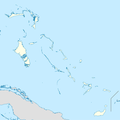Inagua is the southernmost district of the Bahamas comprising the islands of Great Inagua and Little Inagua.
Great Inagua is the third largest island in The Bahamas at 596 sq mi (1544 km²) and lies about 55 miles (90 km) from the eastern tip of Cuba. The island is about 55 x 19 miles (90 x 30 km) in extent, the highest point being 108 ft (33 m) on East Hill. It encloses several lakes, most notably the 12-mile (19 km) long Lake Windsor (also called Lake Rosa) which occupies nearly 1/4 of the interior. The population of Great Inagua is 969 (2000 census).
The island's capital and only harbour is Matthew Town, named after George Matthew a 19th century Governor of the Bahamas. This town houses the Morton Salt Company's main facility, producing one million tonnes of sea salt a year - the second largest solar saline operation in North America and Inagua's main industry. Great Inagua Airport is located nearby.
There is a large bird sanctuary in the center of the island with a population of more than 80,000 of American Flamingoes and many other exotic birds such as Roseate Spoonbills, pelicans, herons, egrets, and Bahama Pintail ducks.
The neighbouring Little Inagua five miles (8 km) to the northeast is uninhabited and occupied by a Land and Sea Park. It is 30 sq mi (78 km2) and has herds of feral donkeys and goats (descendants of stock introduced by the French). Little Inagua has a large protective reef that prevents boats from coming too close.
The original settler name Heneagua was derived from a Spanish expression meaning 'water is to be found there'. Local legend has it that former Haitian tyrant Henri Christophe, king of Haiti from 1811 to 1820, buried treasure at the Northeast Point of Great Inagua where he had a summer retreat.
Several documented treasure laden ships were destroyed on Inaguan reefs between the years of 1500 and 1825. The two most valuable wrecks lost off the Inaguas were treasure-laden Spanish galleons: the Santa Rose (1599) and the Infanta (1788). Other ships of considerable value were the British HMS Statira and HMS Lowestoffe in 1802, and the French Le Count De Paix in 1713.

